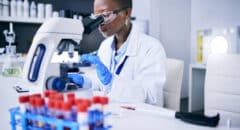 The testicles, the two small, but important organs around the size of a golf ball, play a critical role in the male reproductive system and hold some crucial functions. The testes, found in the testicles, produce testosterone which leads to sperm production.
The testicles, the two small, but important organs around the size of a golf ball, play a critical role in the male reproductive system and hold some crucial functions. The testes, found in the testicles, produce testosterone which leads to sperm production.
READ: 5 Foods That Increase Sperm Count
Male infertility may not be talked about much, but research has shown that 90% of male infertility issues stem from not being able to produce enough sperm. But, infertility isn't the only concern or reason to know what's going on in the love below. Bigger isn't always better.
Why Size Matters
Size does matter when it comes to your testicles, and it’s important for you to know whether yours are healthy. Lumps, swelling or pain may be a sign of unhealthy testes. While it’s normal for one testicle to be bigger than the other, there should only be a slight difference.
Large testes could mean:
Heart Problems: The sex organs are connected to the heart after all, but for men with larger testes not in a good way. A 2013 study found that men with larger testes had a higher risk of developing heart disease. Researchers believe this could be linked to having more of the luteinizing hormone, responsible for stimulating the production of testosterone.
READ: 25 Best Foods To Feed Your Penis
Testicular Cancer: According to the American Cancer Society, testicular cancer can occur in a man of any age, but is most prevalent in men between the ages of 20 and 34. A typical symptoms of testicular cancer is a painless lump on or in a testicle. The testicle may also be larger in size without a lump being present. Most tumors in the testes are painless, but sometimes there can be pain associated with the tumor. Other commonly reported signs of testicular cancer include a dull or aching feeling in the scrotum or lower abdominal area. In rare cases, a man’s breast may grow or become sore because of increased levels of the hormones. Decreased sexual desire can occur earlier as well.
If testicular cancer has spread to other areas of the body an individual can be symptomless or they may experience lower back pain indicating the presence of cancer in the lymph nodes. Chest pain, coughing, including coughing up blood, are other symptoms.
How to Perform a Testicular Exam
Regular check-ups of your testicles are necessary so that you can learn what is normal and abnormal for you. If you check your testicles regularly, in time you will learn what’s normal for your test and be able to tell when something is out of the norm and can treat concerns early.
If you want to do a testicular self-exam to ensure that your testes are normal, the best time to do so is following a bath or shower, when the skin of the scrotum is more relaxed.
Here’s the best way to perform a testicular exam:
- Move your penis out of the way and check one testicle at a time.
- Place the testicle between your thumbs and fingers of both of your hands. Roll it gently between your fingers.
- Look and make sure you feel around for any hard lumps, bumps or a change in size, consistency and shape of your testicles.
When performing a testicular exam, do not be concerned if you feel a small, coiled tube (epididymis) which can also feel like a small bump. The epididymis is usually located on the upper or middle outside side of the testicle. Also, if your testicles are healthy, they will have blood vessels, supporting tissues, along with the tube which carries the sperm through your penis. Don’t confuse these things with abnormal lumps. But, if you are still in doubt, contact your physician who can perform an exam on you.









